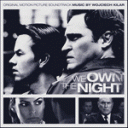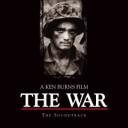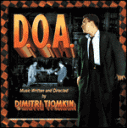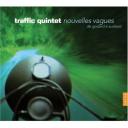We Own The Night/Kilar
October 31, 2007
 Minimalism is the word to describe the score material that Wojciech Kilar wrote for the James Gray film We Own The Night starring Joaquin Phoenix and Mark Wahlberg as two brothers who eventually join forces to fight a Russian mafia drug lord. Taking place in 1988 New York, the film also stars Eva Mendes and Robert Duvall.
Minimalism is the word to describe the score material that Wojciech Kilar wrote for the James Gray film We Own The Night starring Joaquin Phoenix and Mark Wahlberg as two brothers who eventually join forces to fight a Russian mafia drug lord. Taking place in 1988 New York, the film also stars Eva Mendes and Robert Duvall.
The soundtrack from Lakeshore is divided into two distinct sections. The first 11 tracks are source material ranging in diversity from Blondie and David Bowie to Louis Prima/Keely Smith and Jackie Gleason/Bobby Hackett. This review will concentrate on the Kilar original material written for the film. If you have seen the film or are familiar with the source material, you’ll have to be the judge as to whether or not the material strikes your fancy enough to purchase. Bobby, “The Sweetest Horn in the World”, Hackett always gets my attention for the smooth playing he does on the coronet with the lush strings of Gleason backing him on the standard “I’ll Be Seeing You”.
Minimalism music by definition is impersonal and repetitious in nature and “Club Raid” and “Vadim Escapes” are nothing more than the guitar and harp offering a couple of different chords repeated over and over with the strings in the background providing the same continuous note. “Dad Visits Bobby” and “Planning the Bust” are almost the same except this time there is addition of the oboe that performs a simple melody. The “End Credits” offer the same theme on the oboe except the solo is expanded sounding like a Russian tone poem about the Arab world. “Bobby Gets News”, “Funeral”, and “Vadim dies are the same theme of mournful funeral music with the exception of drum rolls in “Funeral”. “Bobby Kiss Amada”, “Bobby and Joe Talk”, and “Bobby Breaks Leg” are a music box style theme performed on the xylophone which brought the simple music box theme that Morricone used in For A Few Dollars More” to mind. “Burt Dies” is as loud and tense as the music gets with a few beats from the timpani and low chords on the piano.
The music box theme is one that is so hauntingly simple that it is one that this reviewer will remember over time. Minimalism music is something that you must acquire a taste for. The first time this reviewer heard Glass the word noise came to my mind. How can anyone possible sit and listen to this? But there is musical structure to this type of music just like 12 Tone. Like Phillip Glass, Wojciech Kilar writes this simple style of music quite well. Naxos, always a very good value, offers in their film music classic series a Kilar CD (#8.557703) of 5 of his films including Bram Stoker’s Dracula his international introduction. While these aren’t complete they are a nice compilation of his material. Kilar was paid to write and produce a particular emotion from the audience which he does. Yes it does serve to fill the speakers with sound during appropriate scenes where music is needed, but it is also much more than that. Worth a listen.
Track listing
1. Heart Of Glass (05:48)
Blondie
2. Let’s Dance (04:08)
David Bowie
3. Rapture (06:28)
Blondie
4. Message To You Rudy (02:53)
The Specials
5. A Little Bit Of Soap (02:14)
The Jarmels
6. Que Pasa Me No Pop I (06:20)
Coati Mundi
7. Should I (02:03)
Louis Prima
8. Maraca (06:03)
Descarga Total
9. I Ain’t Got Nobody (04:38)
Louis Prima & Keely Smith
10. Mambo Diablo (04:10)
Tito Puente
11. I’ll Be Seeing You (03:03)
Jackie Gleason
12. Club Raid (01:31)
13. Dad Visits Bobby (01:30)
14. Bobby Gets News (00:43)
15. Bobby Sees Joe (02:08)
16. Bobby Kiss Amada (01:25)
17. Bobby Breaks Leg (01:46)
18. Vadim Escapes (02:59)
19. Burt Dies (01:03)
20. Funeral (01:08)
21. Bobby And Joe Talk (00:50)
22. Planning The Bust (01:48)
23. Vadim Dies (02:46)
24. End Credits (02:56)
Total Duration: 01:10:21
Lakeshore #339502
War: A Ken Burns Film/Various Artists
October 25, 2007
 Ken Burns, in my opinion, is one of the finest historians around. His documentaries on jazz, baseball, and the civil war are all top notch. The War documentary, a 14+ hour excursion into World War 2 is no exception. Not only is he a good storyteller but he has come up with footage that has never been seen before. I would highly recommend watching this special on PBS network, checking it out of your local library, or purchasing the DVD set albiet a tough watch. My father was involved in Iwo Jima to the extent that he had to pick up the leftover Marines who survived the battle, so there is more than just a passing interest in this for me.
Ken Burns, in my opinion, is one of the finest historians around. His documentaries on jazz, baseball, and the civil war are all top notch. The War documentary, a 14+ hour excursion into World War 2 is no exception. Not only is he a good storyteller but he has come up with footage that has never been seen before. I would highly recommend watching this special on PBS network, checking it out of your local library, or purchasing the DVD set albiet a tough watch. My father was involved in Iwo Jima to the extent that he had to pick up the leftover Marines who survived the battle, so there is more than just a passing interest in this for me.
This is a case where the soundtrack away from the documentary is truly a wonderful listen even though much of it is a compilation of previously written material. The choice of using the adagio style beginning cadenza of the Copland Concerto for Clarinet was nothing short of a stroke of genius. Used on several occasions in the documentary, the tragic melody sets the mood for the overall horror of the documentary. While not considered the main theme, this reviewer considers it to be. While a Benny Goodman/Aaron Copland recording was used in the soundtrack, there is a fine Naxos recording of the complete work (#8.559069) featuring the Nashville Chamber Orchestra with Laura Alden as soloist. While only a portion is used in the soundtrack it is a 17+ minute work which also consists of some pretty darn good jazz material. As Naxos is always such a good value this work is definitely worth exploring in its entirety. If you’re anything like me you’ll find yourself whistling the theme. My significant other made the comment to me the other day in the car that I was whistling which I rarely do, some theme which she wasn’t familiar with. It got stuck in my brain for sure! The other purely classical work of interest is ‘Death of Falstaff’ taken from Henry V. The Walton adagio is the same vein as Barber’s ‘Adagio for Strings’ and is used on several occasions during the documentary.
There is plenty of source material written during the era. ‘Wang Wang Blues’ from Goodman, ‘Solitude’ from Ellington, and ‘How Long Blues’ from Basie are just some of the material. And it is sequenced in such a way that you’re given doses of classical, original material from Marsalis, singing from Crosby, Starr, and the Nat King Cole Trio, as well as other material.
Upon first listen I wasn’t real impressed with the Marsalis material as it seemed out of place during some of the documentary. However, listening to ‘Until I’m In Your Arms Again’ on CD away from the film, gave me a greater appreciation for the material. The same can also be said for the bluesy ‘Movin Back’ and heartwarming ‘America My Home’. ‘In The Nick Of Time’ taken from a Sony Classical album (60864) Short Trip Home features the bass of composer Edgar Meyer who seems most comfortable with this unusual bluegrass material. Yo-Yo Ma conjures up his middle eastern material ‘Blue As The Turquoise Night of Neyshabur’ with his Silk Road Ensemble. The featured song is ‘American Anthem’ first sung by Norah Jones and then played as a duet to end the soundtrack may likely be the most popular due to the sentimental American tribute of the material.
Having grown up with the Richard Rodger’s Victory At Sea material I was quite surprised at how much this particular CD has grown on me. Both the film and the soundtrack are worth looking into.
Golden Scores Rating is (***1/2)
Produced by Ken Burns
CD# is 88697-10203 2
Track listing
1. American Anthem (previously unreleased) (05:07)
Norah Jones
2. Walton: The Death Of Falstaff (03:37)
London Philharmonic Orchestra
3. The Wang Wang Blues (02:52)
Benny Goodman Sextet
4. Movin Back (previously unreleased) (02:46)
Wynton Marsalis
5. How Long Blues (02:58)
Count Basie
6. In the Nick of Time (06:13)
Mike Marshall
7. It’s Been A Long, Long Time (02:59)
Les Paul
8. America My Home (previously unreleased) (02:17)
Wynton Marsalis
9. If I Could Be With You (One Hour Tonight) (02:48)
Capitol International Jazzmen
10. Blue As The Turquoise Night Of Neyshabur (04:27)
Silk Road Ensemble Excerpt
11. Until I’m In Your Arms Again (previously unreleased) (02:41)
Wynton Marsalis
12. Part: Variations For The Healing Of Arinushka (05:10)
Kalle Randalu
13. Basie Boogie (02:23)
Count Basie Orchestra
14. Solitude (03:14)
Duke Ellington & His Orchestra
15. Copland: Concerto For Clarinet, Strings, Harp, And Piano (07:44)
Columbia Symphony Orchestra
16. If You Can’t Smile And Say Yes (02:34)
King Cole Trio
17. American Anthem (previously unreleased) (01:44)
Amanda Forsyth
Total Duration: 01:01:34
D.O.A./Tiomkin
October 15, 2007
For many years I had the main theme to this good ‘B’ movie on a cassette. I had recorded the main theme as well as 40 others from VHS tapes I had watched over the years. While not having heard the theme for quite sometime, the minute I listened to the “main title” I recognized it instantly. The 1950 film starring Edmond O’Brien is in the real bargain category these days. Look in these $1.00 bins and don’t be surprised if you don’t see it.
Tiomkin took the main theme he created and effectively used it for much of the score. The “Main Title” is used as a march like music to follow O’Brien as he walks through the different areas of the police department as the credits are played at the beginning of the film. It appears again as a dance band arrangement with sax solo in “Juke Box Theme”. “Phone Call” is a romantic treatment as well as the short cue “Paula’s Love Note”. “D.O.A.”, the end track of the film, is given the full orchestra treatment albiet a small one with the budget Tiomkin had to work with. This track sounds more like the Tiomkin we are use to listening to. There is no information given as to the size of the orchestra, recording dates etc. but it sounds like something in the 30-40 piece size.
Tiomkin creates some excellent source music including “Hotel Rhumba”, “Another Rhumba”, “Fisherman’s Jive”, and “Fisherman’s Blues”. While I am hardly the person to discuss Rhumba music they sound fine to me. The Jive number is a good small group ensemble with sax, drum, and bass playing creating a good tune. In fact if you told me this was a Tiomkin composition I would have told you that you’ve got rocks in your head. It really sounds a lot more like Charlie ‘Bird’ Parker. The Blues track is a Billy Holliday type number sung very nicely. There is no information on who played what or who sang in the numbers. My research ended up with zero information. Both selections could stand on their own merit in any number of jazz compilation material from the 50’s.
“Escape to Nowhere” is one of the better underscore tracks I have heard in a long time. Incorporating Strauss, childrens music, running music, and eerie dream music it tells its own story in 3+ minutes. Even the wolf calls which were done with the slide flute were included in the soundtrack. And yes there is surface noise included at no extra charge! “On The Trail” and “Eddie’s Bar” are the most evident tracks but as explained in the liner notes there was little that could be done. The notes by the way are always excellent. You get a lot of information about the film and the score as well as information about the individual tracks. As I have said before the cd booklets barely fit in the jewel case once you remove them!
Look at this soundtrack as something written for a noir film as opposed to looking for a Tiomkin score. It is not normally what you are use to listening to from Dimitri. While not as radical sounding as The Thing, it is certainly not a lush full orchestra size work. I like it for what it is. A good theme, good source material, and excellent underscore.
Track listing1. Main Title (02:40)
2. Reporting A Murder (01:06)
3. Lover’s Quarrel (01:12)
4. Eddie’s Bar (00:46)
5. Juke Box Theme (01:38)
6. Hotel Rhumba (04:23)
7. Phone Call (01:13)
8. Another Rhumba (01:27)
9. Fisherman’s Jive (03:34)
10. Fisherman’s Blues (02:54)
11. Paula’s Love Note (00:29)
12. Strange Sickness (01:48)
13. Luminous Poison (01:24)
14. Escape To Nowhere (03:25)
15. Don’t Come Paula (02:43)
16. It Was Suicide (00:44)
17. Allison Hotel (02:13)
18. Bill Of Sale (00:52)
19. Tracking Reynolds (00:25)
20. Unknown Assailant (00:56)
21. Assassin Escapes (00:30)
22. Hotel Hoods (00:36)
23. Soft In The Belly (02:24)
24. The Gold Urn (00:48)
25. Taken For A Ride (03:48)
26. Last Farewell (04:08)
27. Stanley’s Confession (01:22)
28. On The Trail (03:21)
29. Retribution (02:13)
30. D.O.A. (01:31)
31. Wolf Calls (00:41)
total time is 57:14
golden scores rating is ***
CD# is SAE-CRS 017
Produced by Faiola and Spaulding
Nouvelles Vagues/Traffic Quintet/Desplat
October 14, 2007
While working on an article for Alexandre Desplat’s new soundtrack Lust, Caution, I became somewhat intrigued with a selection “Dinner Waltz” which was performed by the Traffic Quintet. Something quite unusual was the addition of a double bass, seldom included in a (5) piece ensemble performing classical music. Upon doing a little additional research I discovered this CD which is a selection of film music of famous french film directors. What a wonderful find to discover these transcriptions from Desplat. On the Naive label (#V5093) this CD is available through Screen Archives Entertainment at the time of this writing. Included are (13) different films (3) of which are composed by Alexandre himself. Some of the more familiar films to US readers are Jules and Jim, A Passage to India, and King of Hearts.
One track that immediately got my attention was Peur sur la ville (Night Caller) a 1975 Henri Verneuil action thriller film starring Jean-Paul Belmondo with music by Ennio Morricone. For those of you who are familiar the track begins very much like his 1982 film The Thing with the thump thump thump before the theme appears. While there is no percussion the bass almost doubles as one on this track as well as others on the CD performing drum like sounds. This is no ordinary sounding soundtrack cue. It is filled with off the wall melodies, constant rhythm from the bass, and dissonant harmony. This track alone is well worth the price of admission!
Gato Barbieri is primarily known as a light jazz saxophone player supreme but also did one soundtrack of note, The Last Tango In Paris, and Desplat features it on three separate cues. The 1972 film starring Marlon Brando likely attracted as much attention as it did because of the sex scenes. The haunting main theme is one of the few themes that is performed in a more traditional sounding quintet style. It is quite straight forward and easily recognizable to anyone who has heard the theme before.
This is one CD that immediately got my attention from the very first track! It is chamber music but it isn’t. It is jazz like but it isn’t. It is a soundtrack compilation but a completely different set of works performed that many of you have never heard before. This is a CD that classical, jazz, and soundtrack listeners can all enjoy. Highly recommended!

